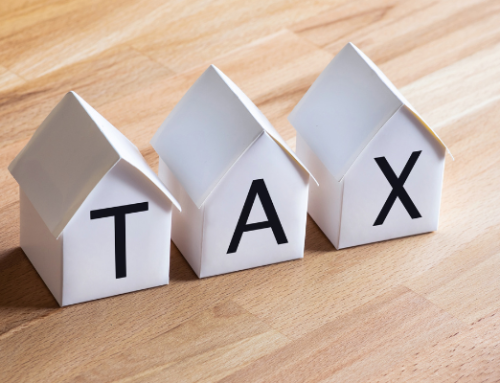In a previous article, we introduced changes to business interest expense deductions via Internal Revenue Code (IRC) Section 163(j), contained in the CARES Act. Final regulations issued in late July 2020 included several technical areas spread out over almost 900 pages. One segment of U.S. businesses that will be impacted more heavily by these revisions is commercial real estate. It will be important for real estate executives to understand how taxable income and interest expense are defined under Section 163(j), as well as which business activities fall under 163(j) guidance.
This is second in a series of articles explaining Section 163(j) and its implications on small businesses, real estate, and manufacturing.
Tentative Taxable Income (TTI)
The final regulations introduced a new term: “tentative taxable income.” Under the proposed regulations, Adjusted Taxable Income (ATI) is defined as the “taxable income” (as defined by code section 63) of the taxpayer for the taxable year, with certain specified adjustments. In practice, these adjustments are the most common:
- Business interest expense
- Business interest income
- Section 172 Net Operating Losses
- Depreciation, Amortization and Depletion in taxable years prior to January 1, 2022
- Any income, deduction, gain or loss which is not “trade or business”
- Adjusted basis adjustments for sale of assets (claiming depreciation, amortization and depletion deducted during tax years 2018 – 2021
The final regulations state that tentative taxable income is generally determined in the same manner as taxable income under section 63, but is computed without regard to the application of the section 163(j) limitation, and without regard to any disallowed business interest expense carryforwards. These items are not considered to ensure that disallowed business interest expense carryforwards are taken into account only once and to avoid creating an “iterative loop”, as explained in the final regulations that takes into account the section 163(j) limitation.
Interest Expense Defined under 163(j)
The proposed regulations included a broad definition of interest, which must be considered when accumulating interest expense for purposes of Section 163(j). The following list illustrates various examples of what is to be included:
- Interest on indebtedness
- Guaranteed payments by partnerships for the use of capital
- Substitute interest payments on securities lending or sale-repurchase transactions
- Debt issuance costs
- Commitment fees
- Premium on debt instruments
- Any income/deductions and gains/losses resulting from transactions used in interest-bearing hedge assets or liabilities
- OID
- Repurchase premiums
The final regulations removed the following from the definition of interest expense under 163(j):
- Commitment fees and other lending fees
- Debt issuance costs
- Guaranteed payments (unless anti-abuse rules apply)
- Any income/deductions and gains/losses resulting from transactions used in interest-bearing hedge assets or liabilities
- Substitute interest payments on securities lending or sale-repurchase transactions ONLY if entered into by the taxpayer in the ordinary course of its business (lending transactions are still considered interest)
A note worth mentioning in this section is the Anti-Avoidance Rules. These rules require that any expense or loss be treated as interest expense under 163(j) if the expense or loss is economically equivalent to interest and if the primary intention for the transaction is to reduce interest expense. The final regulations Section 1.163(j)-1(b)(22)(v) contain examples of the broad scope of the authorities as it relates to the application of these rules.
Important Guidance for the Real Estate Industry
The final regulations highlighted real property trades or businesses making an election out of 163(j). A taxpayer or entity that operates a rental real estate activity would be permitted to make an election as a “real property trade or business” if the activity rises to the level of section 162 trade or business.
The key takeaway in this guidance deals with rental real estate activities that do not qualify as a section 162 trade or business. Such activities may still elect to be treated as an electing real property trade or businesses. As well, under the prior rules, if a taxpayer was exempt under the “small business exemption” they could not elect to be an electing real property trade or business. The final regulations changed this. Going forward, a business can elect out of 163(j) by choosing to use the small business exemption or the electing real property trade or business exemption.
This is an important rule change because now entities can elect out of 163(j) as an electing real property trade or business (instead of using the small business exemption). This would benefit the partner(s) since their partnership interests will now belong to an excepted business. If a partner is not a small business taxpayer, they would have to re-test business interest expense that was otherwise exempt. The final regulations allow small business taxpayers to make an election out of 163(j) as an “electing real property trade or business” so that their partners/investors don’t have to trace this interest and re-test. Partnerships able to do this will have fewer reporting requirements and footnote disclosures.
Additionally, there is an anti-abuse rule mentioned in the final regulations, which states that if 80 percent or more of a real property trade or business real property is leased to a related party, a real property trade or business election may not be made. The anti-abuse rules also prevent the use of tier structured entities to exploit the business interest expense limitations.
An honorable mention for the real estate industry: the final regulations permit eligibility for the real property trade or business election for triple net leases.
Tiered Partnerships
Practical application of 163(j) with tier structured entities has been a challenge from the beginning. The Treasury and IRS have received comments regarding whether, in tier structured entities, the carryforwards are allocated through the upper-tier partnerships (UTP) and how or when an upper-tier partner’s basis should be adjusted when a lower-tier partnership is subject to 163(j). This is not addressed by the final regulations. However, it is discussed in the New Concurrent Proposed Regulations.
The New Proposed Regulations suggests treatment of excess business interest expense (EBIE) in tiered partnerships using the Entity Approach. Both the Treasury and the IRS have concluded “that an Entity Approach is the most consistent with the approach taken to partnerships under section 163(j)(4).” Under this approach, if a lower-tier partnership allocates excess business interest expense to an upper-tier partnership, then the upper-tier partnership reduces its basis in the lower tier partnership. The excess business interest expense is treated as a section 705(a)(2)(b) expense and reduces the capital accounts of the upper-tier partners under section 704(b). The partners in the upper tier do not adjust their basis until the partnership treats the excess business interest as business interest expense. The Treasury and IRS feel that partnerships are “better able to comply with section 163(j)-tiered partnership rules than partners.”
Since these are only new proposed regulations, it may still be possible to carry the excess amounts through to the final tier. This creates a transition issue for partnerships that have previously not used the entity approach, but may do so prospectively.
Gross Receipts Test and Aggregation
The mere mention of this section causes great anxiety in many taxpayers. However, it is an area that is very important when determining if code section 163(j) applies. Treasury and IRS are aware of the complexity of these rules, and there are different code sections that cover application of the gross receipt aggregation rules. Code section 448(c) applies to corporations and to partnerships with a C corporation partner, where sections 52(a), 52(b) 414(m) and 414(o) apply to a broader range of entities.
The final regulations remove the reference to the aggregation rules from the proposed regulations and must apply 448(c) as if they were a corporation or a partnership. However, in the end, taxpayers should treat themselves as the type of entity they actually are in applying sections 52(a), 52(b), 414(m) and 414(o).
Self-charged Interest
If you are a partner with a direct interest in the partnership a loan is made to, there will be an issue with self-charged interest. The final regulations did not address this issue.
However, the new proposed regulations state that the lending partner should treat the interest income received as excess business interest income to the extent of excess business interest expense from the partnership.
The previous topics are a few of the many changes in the final regulations. We now have more clarity on matters related to 163(j). However, many unresolved items have been left for future guidance. Even though these final regulations are more taxpayer-friendly, some taxpayers may still desire to use the original proposed regulations. This decision is fine for now, but be aware that tax years beginning after October 2020 the new final regulations will apply to everyone.





